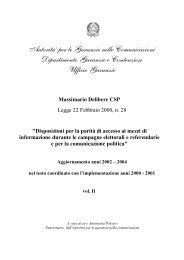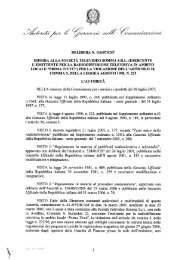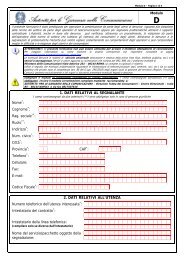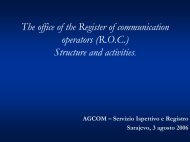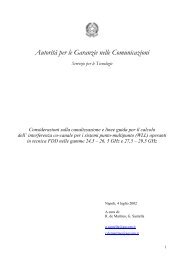Communications Regulatory Authority
Communications Regulatory Authority
Communications Regulatory Authority
Create successful ePaper yourself
Turn your PDF publications into a flip-book with our unique Google optimized e-Paper software.
- the obligation to allocate to independent content providers a share within<br />
40% of the broadcasting capacity of digital terrestrial networks, as set<br />
out in article 2 b, paragraph 1, fifth sentence, of law no. 66/01;<br />
• with respect to RTI:<br />
- the obligation to use, according to the schedule set out in Resolution no.<br />
136/05/CONS, an advertising licensee different from Publitalia for<br />
advertising investments relating to digital terrestrial broadcasts different<br />
from simulcast;<br />
- the prohibition to broadcast advertisements in the context of digital<br />
terrestrial television broadcasts different from simulcast to an extent<br />
above 12% of each hour from 30 June 2005 to 31 December 2006;<br />
• with respect to RAI:<br />
- the obligation to help spread the digital terrestrial technology by means<br />
of a new generalist programme, to be audience-appealing and<br />
advertisement-free on digital terrestrial networks;<br />
• with respect to Publitalia:<br />
- the obligation to apply (until the provision is implemented which<br />
requires RTI to use an advertising licensee different from Publitalia for<br />
advertising investments relating to digital terrestrial broadcasts different<br />
from simulcast) the accounting separation between advertising<br />
investments relating to analog networks and those relating to digital<br />
terrestrial networks;<br />
- the obligation to apply transparent, fair and non-discriminatory terms to<br />
the sale of advertising space, and to highlight separately any discounts<br />
allowed on individual products.<br />
In particular, as far as network access is concerned, AGCOM considered that, in<br />
order to affect the development of pluralism, it would be useful to set out a share of<br />
broadcasting capacity to be transferred to independent content providers whose<br />
programme schedule is suitable to diversify the allocation of advertising resources,<br />
especially if such broadcasters are particularly appealing in terms of audience.<br />
To that end, AGCOM decided to extend in time the applicability of the provision<br />
set forth in article 2 b of law no. 66/01, according to which “any undertaking which<br />
holds more than one television licence shall devote, in each block of digitally<br />
broadcasted programmes and services, equal opportunities and in any case at least 40%<br />
of the broadcasting capacity of said block of programmes and services, under fair,<br />
transparent and non-discriminatory terms, for the testing by other parties which shall not<br />
be parent, subsidiary or affiliated companies”.<br />
Such reservation obligation, to be valid, pursuant to the law, in the framework of<br />
the testing phase involving digital terrestrial television broadcasting, was extended, with<br />
respect to RAI and RTI, by Resolution no.136/05/CONS until full implementation of<br />
the national digital frequency allocation plan.<br />
170




